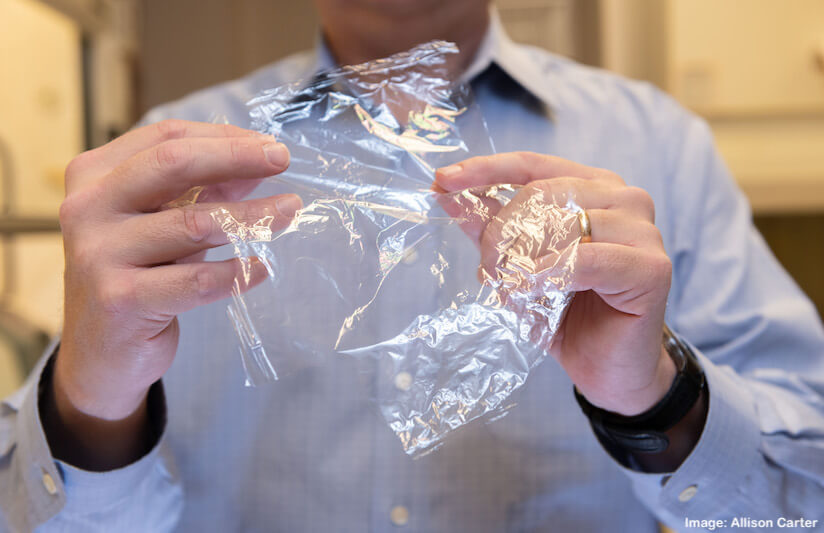An environmentally sustainable material derived from crab shells and tree fibers could replace flexible plastic packaging used to keep food fresh, according to new research from Georgia Institute of Technology.
The researchers have developed a method to spray multiple layers of chitin from crab shells and cellulose from trees to form a flexible film similar to plastic packaging.
The research comes at a time when the market for consumer products made of sustainable and renewable resources is increasingly growing.
The research is published in the journal ACS Sustainable Chemistry and Engineering.
Inspired by natural materials
The researchers began working on the material after finding inspiration from cellulose nanocrystals and chitin nanofibers in their previous work.
The materials are two of the most common natural biopolymers — cellulose, which comes from plants, is the most common, followed by chitin, which is found in shellfish, insects and fungi.
“We had been looking at cellulose nanocrystals for several years and exploring ways to improve those for use in lightweight composites as well as food packaging, because of the huge market opportunity for renewable and compostable packaging, and how important food packaging overall is going to be as the population continues to grow,” J. Carson Meredith, a professor in Georgia Tech’s School of Chemical and Biomolecular Engineering, said in a statement.
They were investigating chitin for an unrelated reason when they had the idea to merge the two together.
“Our original interest was inspired by an insect called the white beetle, where the outer forewing made of chitin is a brilliant white color,” said Meredith.
“We were trying to copy this white color in a renewable material, but found that we could make nice transparent films too.”
They recognized that chitin nanofibers are positively charged and cellulose nanocrystals are negatively charged and decided to test the two as alternating layers in a coating.
“They complement one another in forming a dense, impenetrable structure because they are both crystalline and they are oppositely charged. There are studies that indicate these will compost well together (once they are discarded),” said Meredith.
Developing the product
The team developed a method to create a film by suspending cellulose and chitin nanofibers in water and spraying them onto a surface in alternating layers.
Once the material is fully dried, the result is a flexible, strong, transparent and compostable film.
Not only does it mimic physical properties of plastic film, but it also provides a better gas barrier that prevents oxygen from escaping, according to the researchers.
Food packaging needs to prevent oxygen from passing through in order to preserve food, and the researchers found that the crystalline structure of the film creates a better barrier to prevent gas from escaping.
“It’s difficult for a gas molecule to penetrate a solid crystal, because it has to disrupt the crystal structure,” Meredith said in a statement. “Something like PET [polyethylene terephthalate] on the other hand has a significant amount of amorphous or non-crystalline content, so there are more paths easier for a small gas molecule to find its way through.”

The importance of sustainable alternatives
The researchers used PET, one of the most common petroleum-based materials in transparent packaging, as a benchmark for comparison, and found that their film showed up to a 67-percent reduction in oxygen permeability over some forms of PET.
This means that the new material could, in theory, keep food fresher longer.
Additionally, the ability to replace petroleum-based materials in consumer products could have an enormous impact on the environment, Meredith explained.
“Reducing the amount of non-degrading plastic in oceans and landfills is one major reason,” said Meredith.
“Another is the long-term, inevitable move away from petroleum as an energy source (which may take decades) will require that we find other sources of materials. Most of the petroleum derived plastics are made from byproducts of refining oil for energy. If we no longer have that stream of material, then another source is needed.
“Finally, the U.S. and Europe have ample — in fact surplus — forests. Using them sustainably and rotating growth is good for forests and helps reduce forest fires.”
Next steps
With the amount of cellulose already produced and an easily available supply of chitin-rich byproducts left over from the shellfish food industry, Meredith believes there’s likely more than enough material available to make this packaging a viable alternative to plastic.
However, the researchers still have work to do. For one, more research is needed to improve the material’s ability to block water vapor, and methods to produce chitin could be improved.
But perhaps most importantly, the researchers need to make the new material competitive with plastic packaging on cost.
“It will have to become cost-effective or else it will not become commercial. Right now it is at the lab scale, and processes need to be designed to make large volumes,” said Meredith.
“I don’t think this challenge is any more significant than the challenge of say making paper economically; so, it should be able to be done with investment.”



